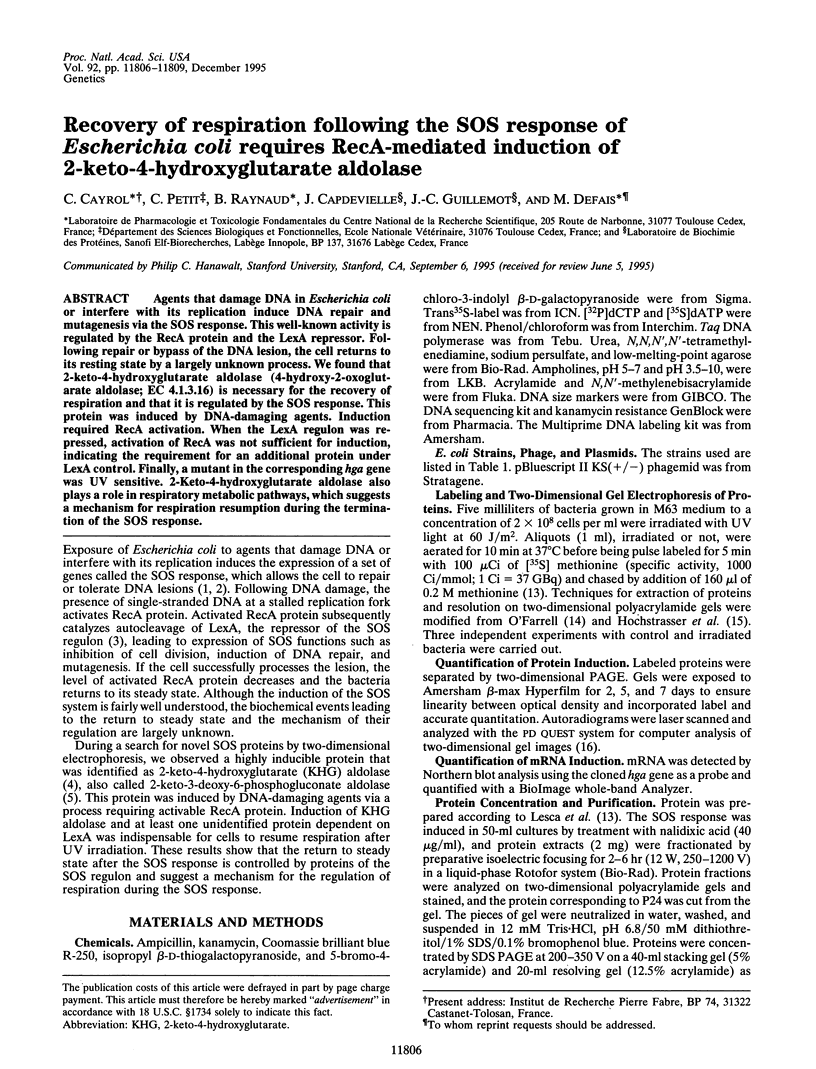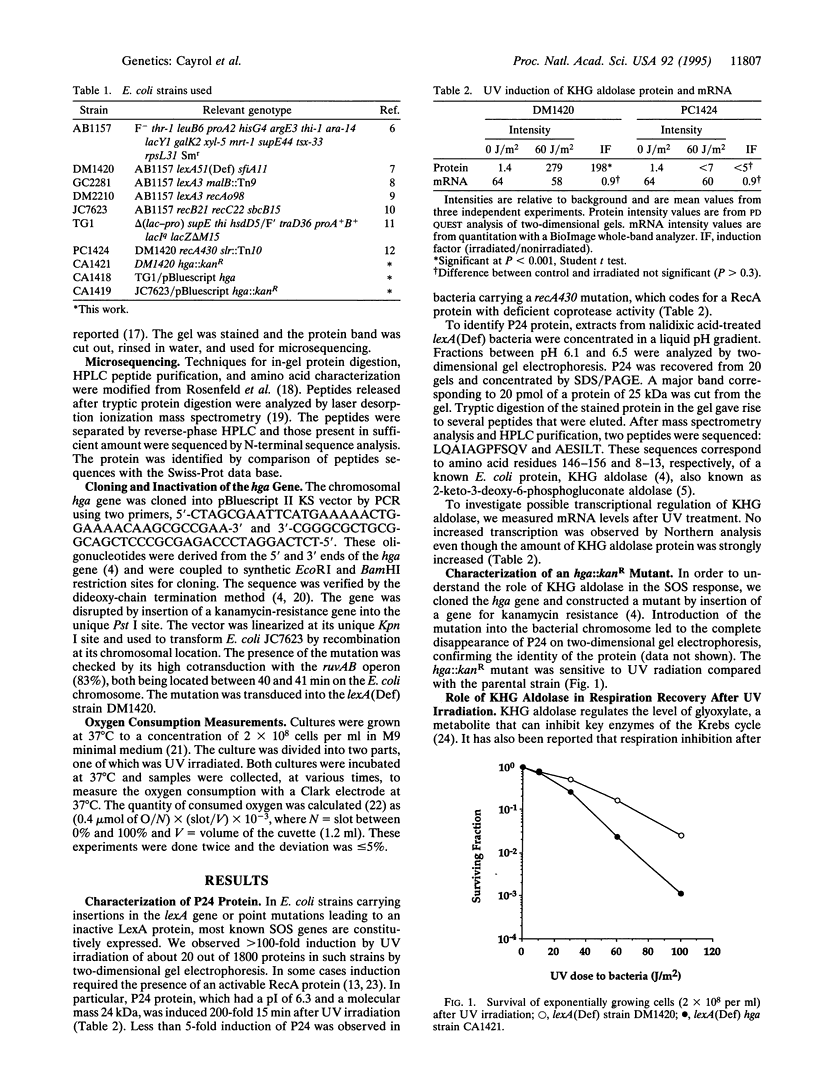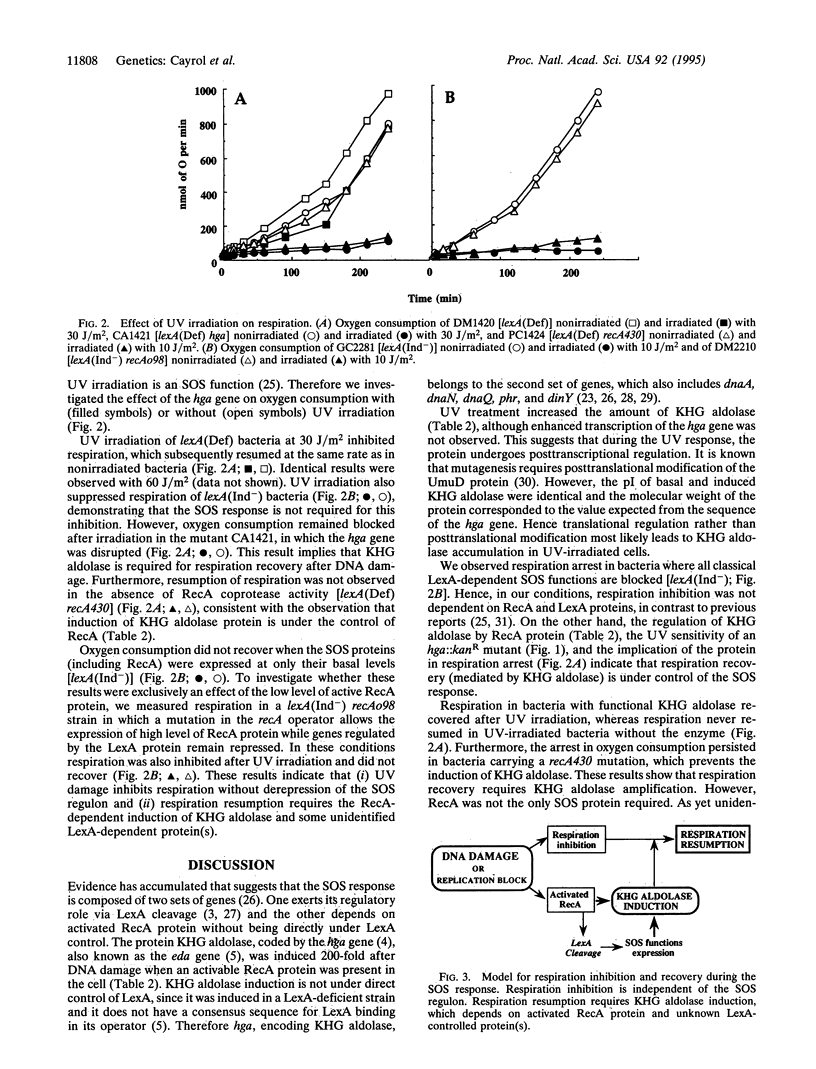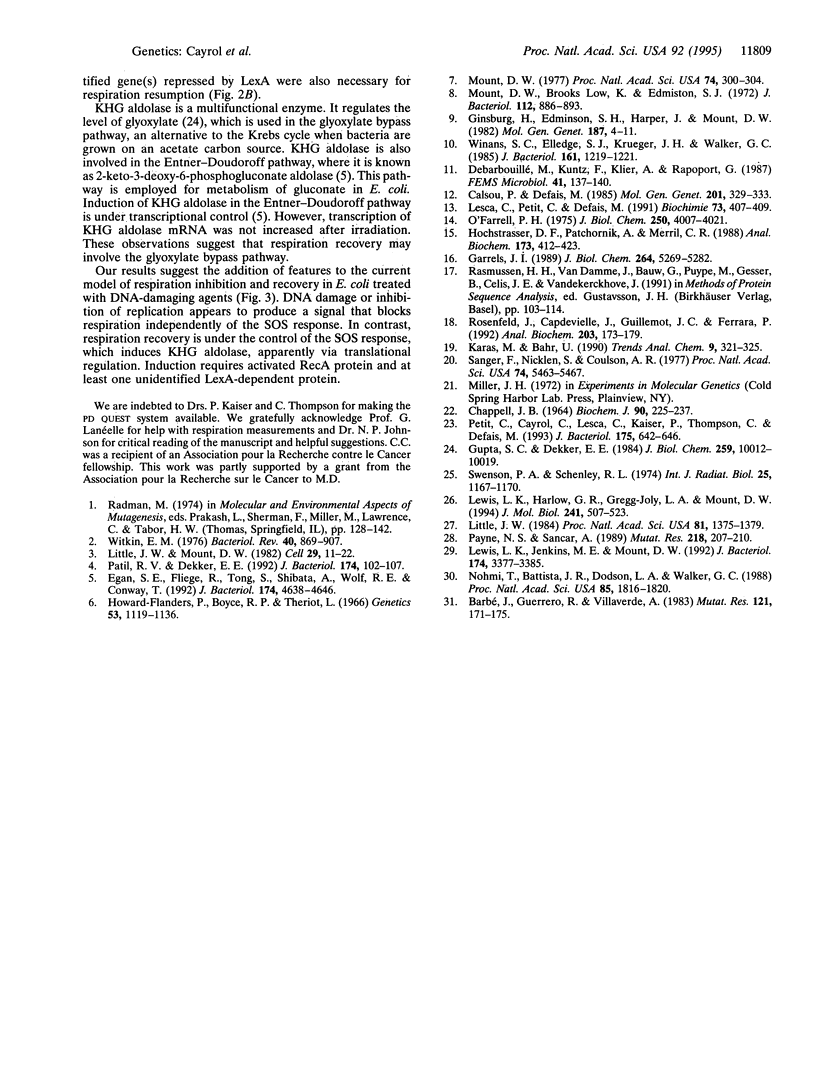Abstract
Agents that damage DNA in Escherichia coli or interfere with its replication induce DNA repair and mutagenesis via the SOS response. This well-known activity is regulated by the RecA protein and the LexA repressor. Following repair or bypass of the DNA lesion, the cell returns to its resting state by a largely unknown process. We found that 2-keto-4-hydroxyglutarate aldolase (4-hydroxy-2-oxoglutarate aldolase; EC 4.1.3.16) is necessary for the recovery of respiration and that it is regulated by the SOS response. This protein was induced by DNA-damaging agents. Induction required RecA activation. When the LexA regulon was repressed, activation of RecA was not sufficient for induction, indicating the requirement for an additional protein under LexA control. Finally, a mutant in the corresponding hga gene was UV sensitive. 2-Keto-4-hydroxyglutarate aldolase also plays a role in respiratory metabolic pathways, which suggests a mechanism for respiration resumption during the termination of the SOS response.
Full text
PDF



Selected References
These references are in PubMed. This may not be the complete list of references from this article.
- Barbé J., Guerrero R., Villaverde A. Further characterization of the expression of SOS functions in recA430 mutants of Escherichia coli. Mutat Res. 1983 Sep;121(3-4):171–175. doi: 10.1016/0165-7992(83)90199-9. [DOI] [PubMed] [Google Scholar]
- Calsou P., Defais M. Weigle reactivation and mutagenesis of bacteriophage lambda in lexA(Def) mutants of E. coli K12. Mol Gen Genet. 1985;201(2):329–333. doi: 10.1007/BF00425679. [DOI] [PubMed] [Google Scholar]
- Chappell J. B. The oxidation of citrate, isocitrate and cis-aconitate by isolated mitochondria. Biochem J. 1964 Feb;90(2):225–237. doi: 10.1042/bj0900225. [DOI] [PMC free article] [PubMed] [Google Scholar]
- Egan S. E., Fliege R., Tong S., Shibata A., Wolf R. E., Jr, Conway T. Molecular characterization of the Entner-Doudoroff pathway in Escherichia coli: sequence analysis and localization of promoters for the edd-eda operon. J Bacteriol. 1992 Jul;174(14):4638–4646. doi: 10.1128/jb.174.14.4638-4646.1992. [DOI] [PMC free article] [PubMed] [Google Scholar]
- Garrels J. I. The QUEST system for quantitative analysis of two-dimensional gels. J Biol Chem. 1989 Mar 25;264(9):5269–5282. [PubMed] [Google Scholar]
- Ginsburg H., Edmiston S. H., Harper J., Mount D. W. Isolation and characterization of an operator-constitutive mutation in the recA gene of E. coli K-12. Mol Gen Genet. 1982;187(1):4–11. doi: 10.1007/BF00384376. [DOI] [PubMed] [Google Scholar]
- Gupta S. C., Dekker E. E. Malyl-CoA formation in the NAD-, CoASH-, and alpha-ketoglutarate dehydrogenase-dependent oxidation of 2-keto-4-hydroxyglutarate. Possible coupled role of this reaction with 2-keto-4-hydroxyglutarate aldolase activity in a pyruvate-catalyzed cyclic oxidation of glyoxylate. J Biol Chem. 1984 Aug 25;259(16):10012–10019. [PubMed] [Google Scholar]
- Hochstrasser D. F., Patchornik A., Merril C. R. Development of polyacrylamide gels that improve the separation of proteins and their detection by silver staining. Anal Biochem. 1988 Sep;173(2):412–423. doi: 10.1016/0003-2697(88)90208-4. [DOI] [PubMed] [Google Scholar]
- Howard-Flanders P., Boyce R. P., Theriot L. Three loci in Escherichia coli K-12 that control the excision of pyrimidine dimers and certain other mutagen products from DNA. Genetics. 1966 Jun;53(6):1119–1136. doi: 10.1093/genetics/53.6.1119. [DOI] [PMC free article] [PubMed] [Google Scholar]
- Lesca C., Petit C., Defais M. UV induction of LexA independent proteins which could be involved in SOS repair. Biochimie. 1991 Apr;73(4):407–409. doi: 10.1016/0300-9084(91)90107-c. [DOI] [PubMed] [Google Scholar]
- Lewis L. K., Harlow G. R., Gregg-Jolly L. A., Mount D. W. Identification of high affinity binding sites for LexA which define new DNA damage-inducible genes in Escherichia coli. J Mol Biol. 1994 Aug 26;241(4):507–523. doi: 10.1006/jmbi.1994.1528. [DOI] [PubMed] [Google Scholar]
- Lewis L. K., Jenkins M. E., Mount D. W. Isolation of DNA damage-inducible promoters in Escherichia coli: regulation of polB (dinA), dinG, and dinH by LexA repressor. J Bacteriol. 1992 May;174(10):3377–3385. doi: 10.1128/jb.174.10.3377-3385.1992. [DOI] [PMC free article] [PubMed] [Google Scholar]
- Little J. W. Autodigestion of lexA and phage lambda repressors. Proc Natl Acad Sci U S A. 1984 Mar;81(5):1375–1379. doi: 10.1073/pnas.81.5.1375. [DOI] [PMC free article] [PubMed] [Google Scholar]
- Little J. W., Mount D. W. The SOS regulatory system of Escherichia coli. Cell. 1982 May;29(1):11–22. doi: 10.1016/0092-8674(82)90085-x. [DOI] [PubMed] [Google Scholar]
- Mount D. W. A mutant of Escherichia coli showing constitutive expression of the lysogenic induction and error-prone DNA repair pathways. Proc Natl Acad Sci U S A. 1977 Jan;74(1):300–304. doi: 10.1073/pnas.74.1.300. [DOI] [PMC free article] [PubMed] [Google Scholar]
- Mount D. W., Low K. B., Edmiston S. J. Dominant mutations (lex) in Escherichia coli K-12 which affect radiation sensitivity and frequency of ultraviolet lght-induced mutations. J Bacteriol. 1972 Nov;112(2):886–893. doi: 10.1128/jb.112.2.886-893.1972. [DOI] [PMC free article] [PubMed] [Google Scholar]
- Nohmi T., Battista J. R., Dodson L. A., Walker G. C. RecA-mediated cleavage activates UmuD for mutagenesis: mechanistic relationship between transcriptional derepression and posttranslational activation. Proc Natl Acad Sci U S A. 1988 Mar;85(6):1816–1820. doi: 10.1073/pnas.85.6.1816. [DOI] [PMC free article] [PubMed] [Google Scholar]
- O'Farrell P. H. High resolution two-dimensional electrophoresis of proteins. J Biol Chem. 1975 May 25;250(10):4007–4021. [PMC free article] [PubMed] [Google Scholar]
- Patil R. V., Dekker E. E. Cloning, nucleotide sequence, overexpression, and inactivation of the Escherichia coli 2-keto-4-hydroxyglutarate aldolase gene. J Bacteriol. 1992 Jan;174(1):102–107. doi: 10.1128/jb.174.1.102-107.1992. [DOI] [PMC free article] [PubMed] [Google Scholar]
- Payne N. S., Sancar A. The LexA protein does not bind specifically to the two SOS box-like sequences immediately 5' to the phr gene. Mutat Res. 1989 Nov;218(3):207–210. doi: 10.1016/0921-8777(89)90005-0. [DOI] [PubMed] [Google Scholar]
- Petit C., Cayrol C., Lesca C., Kaiser P., Thompson C., Defais M. Characterization of dinY, a new Escherichia coli DNA repair gene whose products are damage inducible even in a lexA(Def) background. J Bacteriol. 1993 Feb;175(3):642–646. doi: 10.1128/jb.175.3.642-646.1993. [DOI] [PMC free article] [PubMed] [Google Scholar]
- Rosenfeld J., Capdevielle J., Guillemot J. C., Ferrara P. In-gel digestion of proteins for internal sequence analysis after one- or two-dimensional gel electrophoresis. Anal Biochem. 1992 May 15;203(1):173–179. doi: 10.1016/0003-2697(92)90061-b. [DOI] [PubMed] [Google Scholar]
- Sanger F., Nicklen S., Coulson A. R. DNA sequencing with chain-terminating inhibitors. Proc Natl Acad Sci U S A. 1977 Dec;74(12):5463–5467. doi: 10.1073/pnas.74.12.5463. [DOI] [PMC free article] [PubMed] [Google Scholar]
- Winans S. C., Elledge S. J., Krueger J. H., Walker G. C. Site-directed insertion and deletion mutagenesis with cloned fragments in Escherichia coli. J Bacteriol. 1985 Mar;161(3):1219–1221. doi: 10.1128/jb.161.3.1219-1221.1985. [DOI] [PMC free article] [PubMed] [Google Scholar]
- Witkin E. M. Ultraviolet mutagenesis and inducible DNA repair in Escherichia coli. Bacteriol Rev. 1976 Dec;40(4):869–907. doi: 10.1128/br.40.4.869-907.1976. [DOI] [PMC free article] [PubMed] [Google Scholar]


